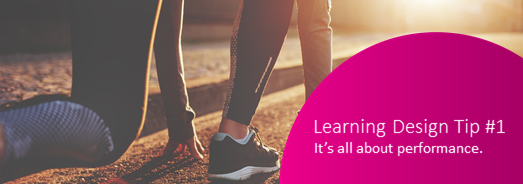‘In this module you will learn …’
Snoozefest. Forget learning outcomes. Wait. Don’t completely forget learning outcomes but make sure that something much more important is driving the learning solutions that you design – performance improvement.
Learning designers have long been wondering how they can get a ‘seat at the table’. It’s easy. Consider the people at the table – CEO, COO, CFO, HR – all people who have a whole-of-business mindset. People who view every decision, every action, every choice through the filter of ‘what impact or benefit will this bring to the organisation?’ When learning designers view what they do through this same filter, the consequence is inevitable – design for performance improvement, for measurable, observable behaviour change. When we approach what we do with this mindset, we begin to earn that seat at that table.
A laser-sharp focus on performance improvement will shape the design solutions that you create. How can you create this focus? Here are five tips that we use at easyA:
1. Ask good questions.
Good questions make people pause and think before answering. They’re open. They align directly to organisational outcomes. They don’t assume that training is the answer to every problem.
‘If all you have is a hammer, everything looks like a nail.’
Abraham Maslow.
2. Start with the end in mind.
Think ahead into the future and imagine that this project is a huge success. What will people be telling you about the outcomes from what you’ve designed? What are they going to be talking about?
‘Don’t think about the start of the race, think about the ending.’
Usain Bolt.
3. Mind the gaps.
Explore the space between the current state and the desired future. How will you help move people towards that desired future success? What knowledge, skills, attributes and environments do people need to get there?
‘The best way to predict the future is to create it.’
Peter Drucker.
4. Find your metrics.
Are the gaps being made visible by any current metrics? Make some friends in the finance and HR teams to get visibility of what is happening through existing data. Work out what metrics you will use to see the desired behaviour change.
‘In God we trust. All others must bring data.’
W. Edwards Deming.
5. Write performance, not learning outcomes.
Reframe your learning outcomes as performance or behaviour outcomes. Move away from describe or explain objectives to actions that people will take.
‘Do or do not. There is no try’
Yoda.
Interested in a deep dive?
- Check out Cathy Moore’s (@CatMoore) Is training really the answer? flowchart.
- Read Ajay Pangarkar’s (@bizlearningdude) book: Building Business Acumen for Trainers.
- John Laskaris (@johnvlaskaris) has written an interesting article on How to Create the Perfect Training: Aligning Business Goals with Business Objectives.
- Will Thalheimer (@WillWorkLearn) looks at how to tweak training evaluation to measure performance in Performance-Focused Smile Sheets.
What will you do?
When you get your next training development request, which of these tips will YOU use to focus on performance?
Get it touch!
Contact us at easyA to explore how our learning solutions design team can work with your organisation: www.easyauthoring.com

